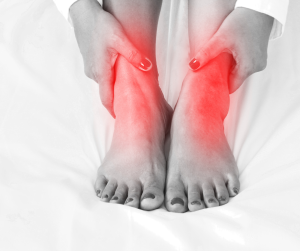

Matthew Solan
LFAC Consultant
Ankle arthritis is a degenerative condition that affects the ankle joint, causing pain, swelling, and reduced mobility. The ankle joint, or tibiotalar joint, is where the tibia (shinbone) meets the talus (a bone in the foot). Arthritis in this joint can significantly impact a person’s quality of life, making daily activities challenging.
This guide aims to provide comprehensive information on ankle arthritis, including its causes, symptoms, diagnosis, treatment options, and strategies for managing the condition.
Anatomy and Function of the Ankle Joint
1.1 Anatomy of the Ankle
The ankle joint is a complex structure composed of three bones: the tibia, the fibula, and the talus. These bones are connected by several ligaments that provide stability and support. The joint is also surrounded by cartilage, a smooth tissue that allows for smooth movement and reduces friction between the bones.
1.2 Function of the Ankle Joint
The ankle joint plays a crucial role in movement and balance. It allows for dorsiflexion (bending the foot upward) and plantarflexion (pointing the foot downward). The ankle is essential for walking, running, and jumping, providing the necessary flexibility and support for these activities.
What is Ankle Arthritis?
2.1 Definition and Types
Ankle arthritis refers to the inflammation and degeneration of the cartilage in the ankle joint. The most common types of arthritis that affect the ankle are:
- Osteoarthritis: A degenerative joint disease characterised by the breakdown of cartilage due to wear and tear.
- Rheumatoid Arthritis: An autoimmune disorder where the immune system attacks the joint lining, causing inflammation and joint damage.
- Post-traumatic Arthritis: Arthritis that develops after an injury to the ankle, such as a fracture or severe sprain.
- Gout: A form of arthritis caused by the accumulation of uric acid crystals in the joint.
2.2 Symptoms of Ankle Arthritis
Common symptoms of ankle arthritis include:
- Pain and tenderness in the ankle joint.
- Swelling and inflammation.
- Stiffness and reduced range of motion.
- Difficulty walking or bearing weight on the affected foot.
- Development of bone spurs (osteophytes).
Causes and Risk Factors
3.1 Causes of Ankle Arthritis
Several factors can contribute to the development of ankle arthritis:
- Aging: Natural wear and tear of the cartilage over time.
- Injury: Previous fractures, dislocations, or severe sprains can damage the cartilage and lead to arthritis.
- Genetics: A family history of arthritis can increase susceptibility.
- Inflammatory Conditions: Autoimmune diseases like rheumatoid arthritis and gout.
- Obesity: Excess weight puts additional stress on the ankle joint.
3.2 Risk Factors
Certain conditions and lifestyle choices can increase the risk of developing ankle arthritis:
- Repetitive Stress: Jobs or activities that require repetitive motion or excessive use of the ankle.
- Sports Injuries: High-impact sports or activities that put stress on the ankle.
- Gender: Women are more likely to develop certain types of arthritis, such as rheumatoid arthritis.
- Joint Abnormalities: Congenital or acquired deformities of the ankle joint.
Diagnosis of Ankle Arthritis
4.1 Clinical Examination
The diagnosis of ankle arthritis begins with a thorough clinical examination by your healthcare provider. This involves:
- Reviewing the patient’s medical history.
- Assessing symptoms and their impact on daily activities.
- Conducting a physical examination of the ankle, including checking for tenderness, swelling, and range of motion.
4.2 Imaging Tests
Imaging tests can help confirm the diagnosis and assess the extent of joint damage:
- X-rays: Reveal joint space narrowing, bone spurs, and other changes.
- MRI: Provides detailed images of the soft tissues and cartilage.
- CT Scan: Offers a more detailed view of the bone structures.
- Standing CT: A newer modality that allows 3D assessment of the joint whilst weight is being transferred through it.
- Ultrasound: Can detect inflammation and soft tissue abnormalities.
4.3 Laboratory Tests
Laboratory tests may be performed to rule out other conditions or to identify the specific type of arthritis:
- Blood Tests: Can detect markers of inflammation (such as ESR or CRP) and antibodies associated with rheumatoid arthritis.
- Joint Fluid Analysis: Examining the fluid in the joint can help diagnose gout or infection.
Treatment Options
5.1 Non-Surgical Treatments
Several non-surgical treatments can help manage the symptoms of ankle arthritis:
5.1.1 Medications
- Pain Relievers: Over-the-counter options like paracetamol or prescription medications.
- NSAIDs: Nonsteroidal anti-inflammatory drugs like ibuprofen or naproxen to reduce pain and inflammation.
- Corticosteroids: Oral or injectable steroids to reduce inflammation.
- Disease-Modifying Antirheumatic Drugs (DMARDs): For rheumatoid arthritis to slow disease progression.
5.1.2 Physical Therapy
Physical therapy can help improve joint mobility and strengthen the muscles around the ankle. Exercises may include:
- Range-of-motion exercises.
- Strengthening exercises.
- Balance and stability exercises.
5.1.3 Orthotic Devices
Custom insoles, ankle braces, or supportive shoes can help reduce pressure on the ankle and provide stability.
5.1.4 Lifestyle Modifications
- Weight Management: Reducing body weight to lessen stress on the ankle joint.
- Activity Modification: Avoiding activities that exacerbate symptoms and incorporating low-impact exercises like swimming or cycling.
5.1.5 Alternative Therapies
- Acupuncture: Can help reduce pain and improve function.
- Massage Therapy: May help reduce muscle tension and improve circulation.
- Supplements: Glucosamine and chondroitin sulfate may provide some relief for osteoarthritis.
5.2 Surgical Treatments
When non-surgical treatments are ineffective, surgical options may be considered:
5.2.1 Arthroscopy
Ankle arthroscopy is a minimally invasive procedure where a small camera and instruments are inserted into the joint to remove loose fragments, bone spurs, or inflamed tissue.
5.2.2 Ankle Fusion (Arthrodesis)
Fusing the bones of the ankle joint together to eliminate pain and provide stability. This procedure results in a loss of joint motion but can significantly reduce pain.
5.2.3 Ankle Replacement (Arthroplasty)
Replacing the damaged ankle joint with an artificial implant. An ankle replace surgery can relieve pain while preserving some degree of joint motion.
Rehabilitation and Recovery
6.1 Post-Surgical Rehabilitation
Rehabilitation is crucial for recovery after surgery for ankle arthritis:
6.1.1 Physical Therapy
A structured program to restore mobility, strength, and function. Therapy may include:
- Gentle range-of-motion exercises.
- Gradual strengthening exercises.
- Balance and proprioception training.
6.1.2 Gradual Weight-Bearing
Slowly increasing weight-bearing activities as healing progresses. This may involve using crutches or a walker initially and gradually transitioning to full weight-bearing.
6.1.3 Pain Management
Medications and techniques to manage post-operative pain, such as pain relievers, ice therapy, and elevation.
6.2 Long-Term Management
Long-term management strategies can help prevent recurrence and maintain joint health:
6.2.1 Regular Exercise
Engaging in regular, low-impact exercise to maintain joint flexibility and strength. Activities like swimming, cycling, and yoga can be beneficial.
6.2.2 Healthy Diet
Maintaining a nutrient-rich diet to support joint health and weight management. Foods rich in omega-3 fatty acids, antioxidants, and anti-inflammatory properties can be particularly helpful.
6.2.3 Footwear
Wearing appropriate shoes with good support and cushioning to reduce stress on the ankle joint. Avoiding high heels and shoes with poor support.
Living with Ankle Arthritis
7.1 Coping Strategies
Living with ankle arthritis can be challenging, but several strategies can help:
7.1.1 Pain Management
Using medications, physical therapy, and alternative therapies like acupuncture or massage to manage pain.
7.1.2 Adaptive Devices
Using sticks or braces to reduce pressure on the affected joint and improve mobility.
7.1.3 Support Groups
Joining support groups for emotional support and shared experiences. Connecting with others facing similar challenges can provide valuable insights and encouragement.
7.2 Lifestyle Adjustments
Making certain lifestyle adjustments can improve daily functioning:
7.2.1 Activity Modification
Avoiding activities that exacerbate symptoms and finding alternative ways to stay active. For example, switching from high-impact sports to low-impact exercises.
7.2.2 Home Modifications
Making changes at home to reduce the risk of falls and accommodate mobility limitations. This may include installing handrails, using non-slip mats, and ensuring proper lighting.
Prevention of Ankle Arthritis
8.1 Preventive Measures
While it may not be possible to prevent ankle arthritis entirely, certain measures can reduce the risk:
8.1.1 Maintaining a Healthy Weight
Reducing stress on the ankle joint by maintaining a healthy body weight through a balanced diet and regular exercise.
8.1.2 Proper Footwear
Wearing supportive shoes that fit well and provide adequate cushioning. Avoiding high heels and shoes with poor arch support.
8.1.3 Avoiding Repetitive Stress
Modifying activities that put excessive stress on the ankle. Taking breaks and using proper techniques during physical activities to reduce the risk of injury.
8.2 Early Intervention
Early intervention can help manage symptoms and slow the progression of arthritis:
8.2.1 Regular Check-ups
Seeing a healthcare provider for early signs of joint problems. Early diagnosis and treatment can prevent further damage and improve outcomes.
8.2.2 Timely Treatment
Seeking treatment promptly for foot injuries. Proper management of sprains, fractures, and other injuries can reduce the risk of developing post-traumatic arthritis.
Advances in Ankle Arthritis Research
9.1 Current Research
Ongoing research is focused on understanding the underlying mechanisms of arthritis and developing new treatments:
9.1.1 Regenerative Medicine
Exploring the potential of stem cells and tissue engineering to repair damaged cartilage and restore joint function. There is not yet any proven benefit to these potentially exciting treatments.
9.1.2 Biologic Therapies
Investigating the use of biologic agents, such as TNF inhibitors and interleukin blockers, to reduce inflammation and slow disease progression in rheumatoid arthritis.
9.1.3 Improved Imaging Techniques
Developing advanced imaging techniques to better assess joint damage and monitor treatment effectiveness.
9.2 Future Directions
Future research may lead to innovative treatments and improved outcomes for patients with ankle arthritis:
9.2.1 Personalised Medicine
Tailoring treatments based on individual genetic profiles and specific disease characteristics. This approach aims to improve treatment effectiveness and minimise side effects.
9.2.2 Advanced Surgical Techniques
Developing less invasive surgical options with quicker recovery times and better outcomes. Techniques like computer-assisted surgery and robotic-assisted surgery hold promise for the future.
Resources and Support
10.1 Finding a Specialist
To find a specialist for ankle arthritis, consider the following:
10.1.1 Referrals
At the London Foot and Ankle centre we offer assessment and advice regarding ankle arthritis. Surgery is only required in a small proportion of cases.
0207 078 3800
10.1.2 Professional Organisation
American Association of Foot and Ankle Surgeons (AOFAS)
British Orthopaedic Foot and Ankle Society (BOFAS)
European Foot and Ankle Society (EFAS)
10.2 Support Groups and Organisations
Support groups can provide valuable resources and support:
10.2.1 Arthritis Foundation
Offers information, resources, and support for people with arthritis. They provide educational materials, support groups, and advocacy efforts.
10.2.2 Local Support Groups
Join local groups to connect with others facing similar challenges. Sharing experiences and strategies can provide valuable insights and emotional support.
Conclusion:
Ankle arthritis is a common condition that can significantly impact a person’s quality of life. Understanding the anatomy, causes, symptoms, and treatment options is crucial for effective management. Early diagnosis and intervention, combined with appropriate lifestyle modifications and treatments, can help alleviate symptoms and improve mobility. Ongoing research holds promise for new and innovative treatments that may further enhance the lives of those affected by ankle arthritis.
By taking proactive steps to manage symptoms, seeking appropriate medical care, and making necessary lifestyle adjustments, individuals with ankle arthritis can lead fulfilling and active lives.
References
- Arthritis Foundation. Types of Arthritis.
- American Academy of Orthopaedic Surgeons. Ankle Arthritis.
- British Foot and Ankle Society. Surgery for Ankle Arthritis
- National Institute of Arthritis and Musculoskeletal and Skin Diseases. Osteoarthritis.
- Rheumatology Research Foundation. Rheumatoid Arthritis.






